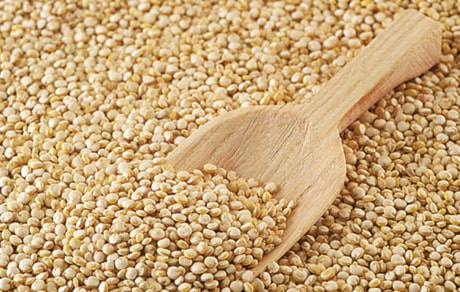It seems as though everywhere you go people are trying to lose weight, have more sustained energy or find something to help with some sort of digestive disturbances.
They’re looking for that miracle supplement or pill.
And while there is never just one miracle answer, this whole food does come close.
It’s usually the first food I recommend to clients looking for healthier alternatives as it is the easiest to prepare, highly nutritious, tastes great, and people get the results they are looking for.
Considered sacred in South America for its spiritually enhancing qualities, this “ancient grain” dates back to over 3000 BC. Although, it is not a grain at all — it is actually a seed, called quinoa (“keen-wa”).
The seed comes from a plant called chenopodium, or goosefoot plant, named after its leaves literally looking like the webbed foot of a goose, and is in the same family as beets, spinach and swiss chard.
There are 120 species of quinoa, although three main varieties you will find at the grocery store: white, red and black, all with similar nutritional properties.
The seed cooks like a grain. After rinsing, it takes about 15 minutes to boil into a fluffy consistency of tiny nutty-flavoured pearls of goodness.
It is actually considered a complete protein as it contains eight out of nine of the essential amino acids — essential meaning it must come from the diet (our bodies do not produce).
The functions of these amino acids range from tissue growth and repair to hormone production, energy regulation, serotonin production, and balancing blood sugar levels in the body.
Quinoa is also high in fibre, calcium, magnesium and iron, and is a relatively good source of vitamin E and several B vitamins. It is also gluten free, so it is excellent for people who have gluten intolerance.
The best part is it’s so versatile that it can literally be eaten at every meal — from breakfast to desert. The Incas even went as far as fermenting it into a beer like beverage called chicha. Can it get any better?
It is also great for babies and children. Half a cup will provide a child’s protein intake for the day.
Eat with fruit and cottage cheese in the morning, in a salad for lunch, in a soup or stir fry for supper and in some baking for dessert (using quinoa flour).
Once cooked, it can be stored in the refrigerator for up to four days.
And if you want to go even further in nutritional value, you can leave it in its raw state and sprout it! Soaking and rinsing it in water over two to three days will leave you with an enzyme-rich superfood.
You may just start to think of it as sacred yourself.
Simple Quinoa Salad
1 cup cooked quinoa, cooled
Veggies: 1 cup snow peas, chopped, ½ red pepper, chopped, 1 medium cucumber, diced, 1 Carrot, sliced thin
½ cup sunflower seeds
¼ cup fresh chopped cilantro
Dressing:
Juice of one lemon
¼ cup olive oil
Optional: fresh garlic and/or ginger
Sea salt and fresh ground pepper to taste
Kristin Fraser, BSc, is a registered holistic nutritionist and local freelance writer. Her column appears every second Wednesday. She can be reached at kristin_fraser@hotmail.com
